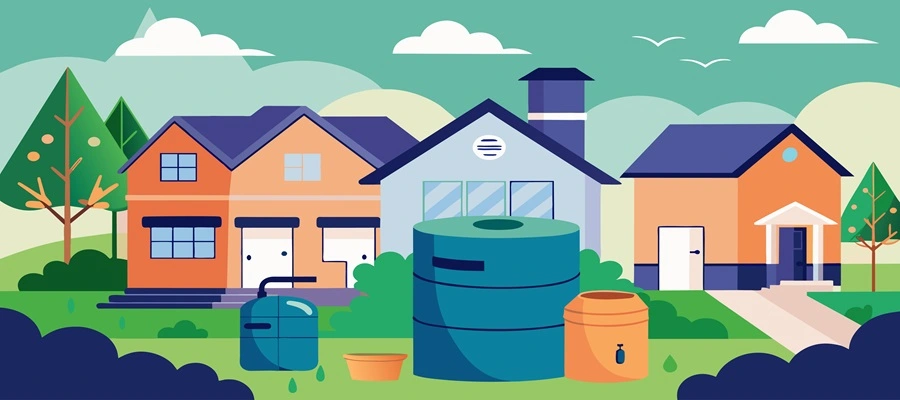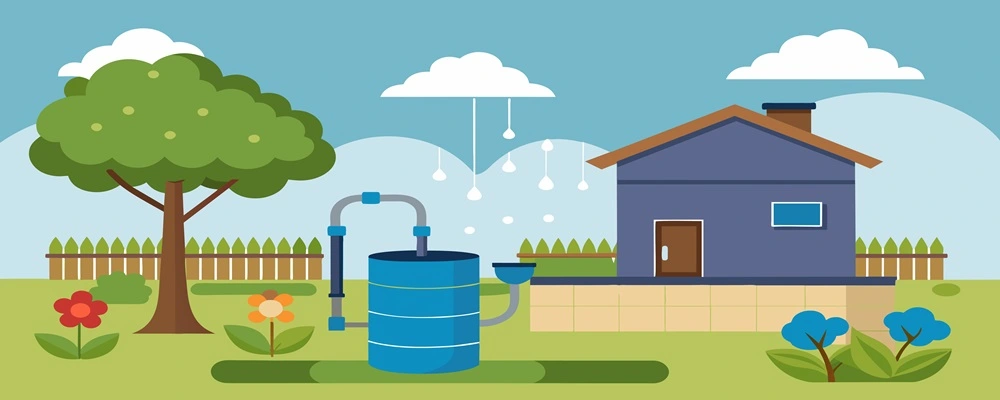Our natural resources are continuously depleting. Besides, there is an urgent demand to address climate change. Keeping these in mind, we cannot deny adopting sustainable water conservation practices. Undoubtedly, groundwater still stands as the primary source of freshwater, fulfilling the nation’s agricultural, industrial and household demands. However, over the years, we are exploiting the groundwater resources for our everyday needs. Moreover, modernization and following modern lifestyles caused tremendous water wastage.
Our water resources are depleting each year. Moreover, we cannot generate artificial water. Instead, we must depend on the water sources available on the planet. With the population boom and excessive need for water to suit modern lifestyles, one can feel the water scarcity all over the world. It gave rise to major concerns over water conservation.
In this context, adopting sustainable practices like rainwater harvesting is the simplest and best measure for conserving global water. Hence, Brick & Bolt‘s primary focus in this blog is on discussing the benefits of rainwater harvesting, exploring the systems, and offering guidelines on implementing the associated rainwater harvesting techniques.
What is Rain Water Harvesting?
Rainwater harvesting refers to a simple strategy where you collect and store rainwater for future uses. It involves using artificially designed systems connected to natural or fabricated catchment areas, like rooftops, compounds, rocky surfaces, hill slopes, and artificially repaired impervious and semi-pervious land surfaces.
You can filter, store, and use the collected rainwater in different ways or directly for recharge. Rainwater harvesting does not cause any kind of impurity. Besides, it requires less storage and no maintenance cost, except regular cleaning. The reliability of rainwater supply depends on the size of your catchment area or the roof, the volume of your storage tank and the management of daily consumption to the local rainfall pattern.
Benefits of Rainwater Harvesting
The following benefits show the importance of rainwater harvesting and how it will help our community and environment.
Ecological Benefit
Storing underground water is environmentally friendly. Since it funnels off the water into large tanks for recycling and reduces the load of the drainage system, it mitigates the impact of flooding. Besides, storing the collected water does not require more land or displacing the population. Therefore, groundwater does not evaporate or pollute directly. Furthermore, it helps minimize the possibility of rivers drying.
Reduced Water Bills
Rainwater harvesting systems are cost-effective. They provide high-quality water, reducing your dependence on groundwater, including wells. You will experience increased groundwater levels as you do not depend on wells. Besides, you can easily maintain the wells since you do not use the water for drinking, cooking, and other sensitive uses. Moreover, the overall cost involved in harvesting and recharging the water to the surface reservoirs is cheaper.
Reduces Erosion and Flooding around Structures
With sustainable water conservation practices, such as rainwater harvesting, there is a reduction in stormwater. It further helps in reducing erosion and floods in the urban areas. If your building is utilizing rainwater, it must have a catchment area on its rooftop. It can collect large volumes of water during heavy rains.
Boosts Groundwater Levels
Rainwater harvesting can increase the periodicity of aquifers, raise groundwater levels, and reduce the demand for potable water. If you live in an area with low water levels, rainwater harvesting is the best solution.
Adequate for Irrigation
Since rainwater harvesting collects large amounts of water, it mitigates the effects of drought. Being free from harmful chemicals, it is suitable for irrigation purposes. In addition, you can also use sustainable landscaping practices to reduce water consumption for your gardening.
Various Rainwater Harvesting Techniques for Your Home

1. Surface Runoff Harvesting
In this method of rainwater harvesting, you collect the rainwater flowing along the ground. During heavy rains, you collect the rainwater in a tank or reservoir for irrigation and other purposes. You can make a reservoir on the surface or underground. You can use the water for farming, cattle farming, and domestic use. Surface runoff harvesting is best suited in urban areas.
2. Rooftop Rainwater Harvesting
It is another method of collecting rainwater. Usually, in rooftop harvesting, you need to collect rainwater in a catchment area of the building. You can collect and store rooftop runoff by using a recharge pit, trench, and tube well. Now, you can also store the collected water in the tanks. You can also send the collected water to an artificial recharge system. They are an alternative water source for activities, including irrigation, flushing toilets and washing cars. When you use harvested rainwater, you depend less on traditional water sources, conserving water and lowering your water bills. Moreover, since rainwater does not contain chemicals, you can water plants and gardens. e
3. Groundwater Recharge
Groundwater recharge involves a hydrologic process wherein the surface water seeps down in the form of groundwater. Groundwater recharge is the primary method through which the water enters an aquifer and serves as a distribution system. You can use the surplus rainwater to recharge the groundwater aquifer through artificial recharge techniques. In rural areas, you can harvest rainwater through dugwell recharge, gully plug, recharge shaft, percolation tanks, check dam and contour band.
Components of a Rainwater Harvesting System
A rainwater harvesting system comprises components belonging to various stages. These include transporting rainwater through pipes and drains, filtration and storage in tanks for future use, reuse and recharge. The common components of a rainwater harvesting system involved in these stages include the following:
1. Catchments
A rainwater harvesting system’s catchment refers to the surface that directly receives the rainwater and offers water to the system. You can create your catchment in a paved area like a terrace or your building’s courtyard or an unpaved area like your lawn or an open ground. You can also harvest rainwater from a roof made from reinforced cement concrete, galvanized iron, and conjugated sheets.
Rooftop catchment areas vary widely, encompassing different designs and materials. Whether you consider the flat, expansive roof of the commercial building or the sloped and tiled roofs of residences, each offers unique advantages and challenges for rainwater collection. Besides, the roof material of your home or building also affects the quality of water collection.
2. Conveyance System
Now, you must focus on conveying the rainwater from the rooftop. It is where your conveyance system, comprising gutter and downspouts, plays a vital role. The designs and materials are also essential, ensuring that the harvested rainwater flows directly and swiftly from the catmint area to the storage tank.
Gutters: Gutters are the horizontal components attached to your roof’s edges. The effectiveness of your gutter system lies in its capacity to handle the volume of water it collects during heavy rain without overflowing. Gutters come in various materials, from aluminium and vinyl to stainless steel and copper. Each material has its benefits and considerations, including cost, maintenance, and durability.
Downspouts: These carry water from the gutters to the storage systems. They form the crucial link, ensuring efficiency and controlling harvested rainwater. It further prevents it from spilling over the sides of the building. Your downspouts’ material selection affects its longevity and functionality. Furthermore, your roof’s size and design play a vital role in positioning and the number of downspouts. It ensures the distribution and efficient direction of water to the storage tanks.
3. Rainwater Pre-Filters
The filters form another significant component of your rainwater harvesting system, as it removes large particulate matter that might feed on and carry harmful bacteria. In the case of a rooftop rainwater harvesting system, filtration forms the first line of defence in safeguarding water quality. You need to place the filters within the system to remove the debris and contaminants, ensuring the storage water is clean and safe for the intended use.
4. Storage Tanks
Without the storage tanks, your list of rainwater harvesting components remains incomplete. The location of the tanks above or below the ground and the material used in manufacturing the tanks play a significant role in your system’s efficiency, longevity and cost. Some of the most common materials used in the manufacturing of the tanks include wood, polyethene and metals. Each of these comes with distinct advantages and challenges. Moreover, you must also consider the tank’s size to balance the demand with the supply of the harvested water. Oversizing will lead to unnecessary costs, whereas undersizing will lead to running out of water during dry spells.
5. Filtration Systems
During the travel from the roof through the collection system, rainwater picks up various contaminants, including dust, organic matter and atmospheric pollutants. Activities like irrigation and industrial applications do not require filtered water. However, if you are using rainwater for domestic water consumption, such as cooking, you must use water that meets high-quality standards. Since the filtration systems help in meeting the standards, they stand as an integral part of the rainwater harvesting system, ensuring a healthy and safe lifestyle.
6. Distribution Systems
Whether you require rainwater for irrigation or household activities, the distribution system influences the overall effectiveness of the entire setup. The system comprises pumps and piping that you can configure in gravity-fed or mechanical systems, each with unique advantages and configurations.
Conclusion
Rainwater harvesting and collection is a sustainable strategy for building eco-friendly homes and adapting to address the problems of the global water crisis. Simple water conservation methods offer incredible solutions in areas that do not experience enough rainfall or have enough groundwater supply.
As a leading construction firm in Faridabad, Brick & Bolt offers complete start-to-finish services combined with real-time tracking, transparent communication, quality checks, and regular project updates. The organization also provide the rainwater harvesting system to their projects on demand.

